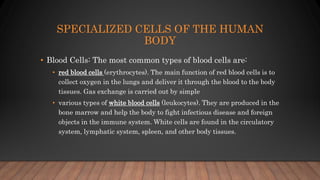Cellular physiology focuses on the scientific study of physiological processes within and among cells. A cell is the fundamental unit of life, and the human body contains trillions of cells. Specialized cell types in the human body include nerve cells, epithelial cells, exocrine cells, endocrine cells, and blood cells. The cell membrane, cytoplasm, organelles, and vesicles work together to allow cellular transport and metabolism. Cellular structures and functions allow the human body to operate at the microscopic level.



























































